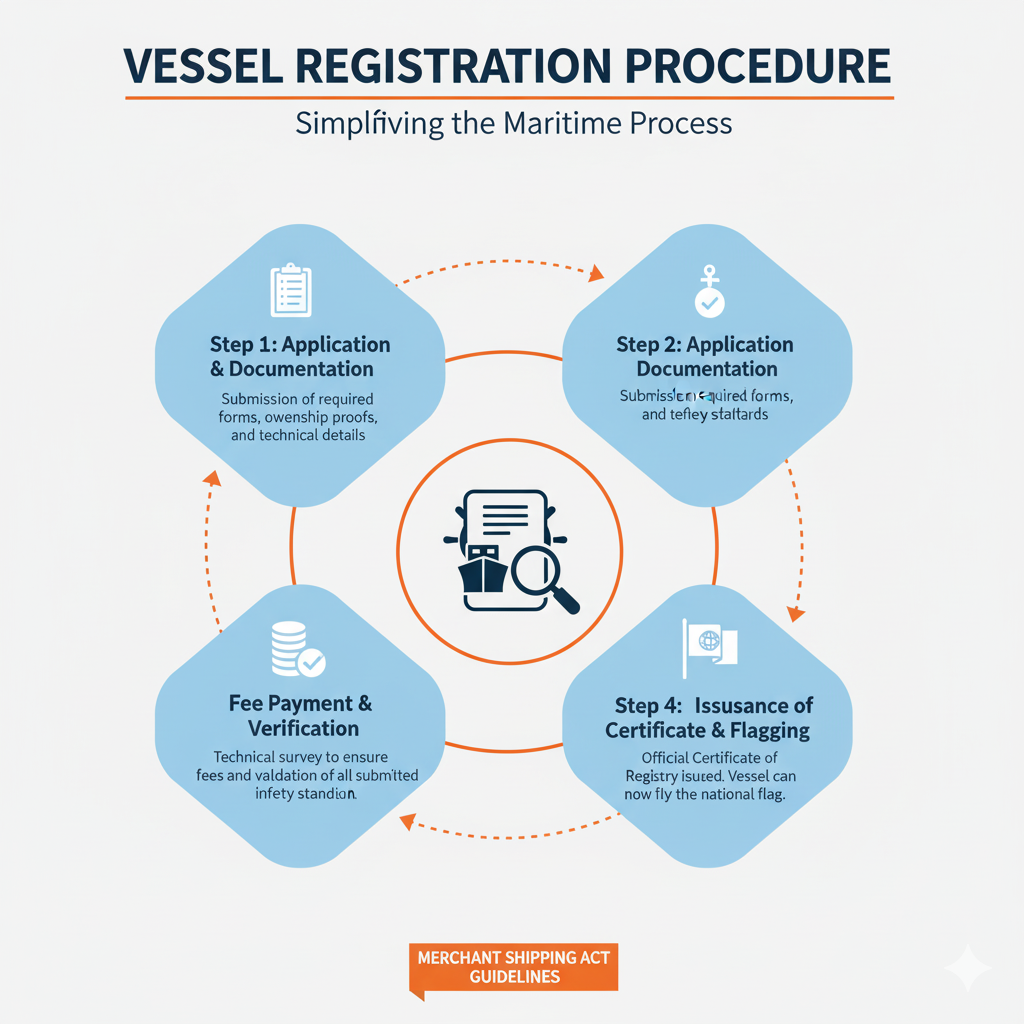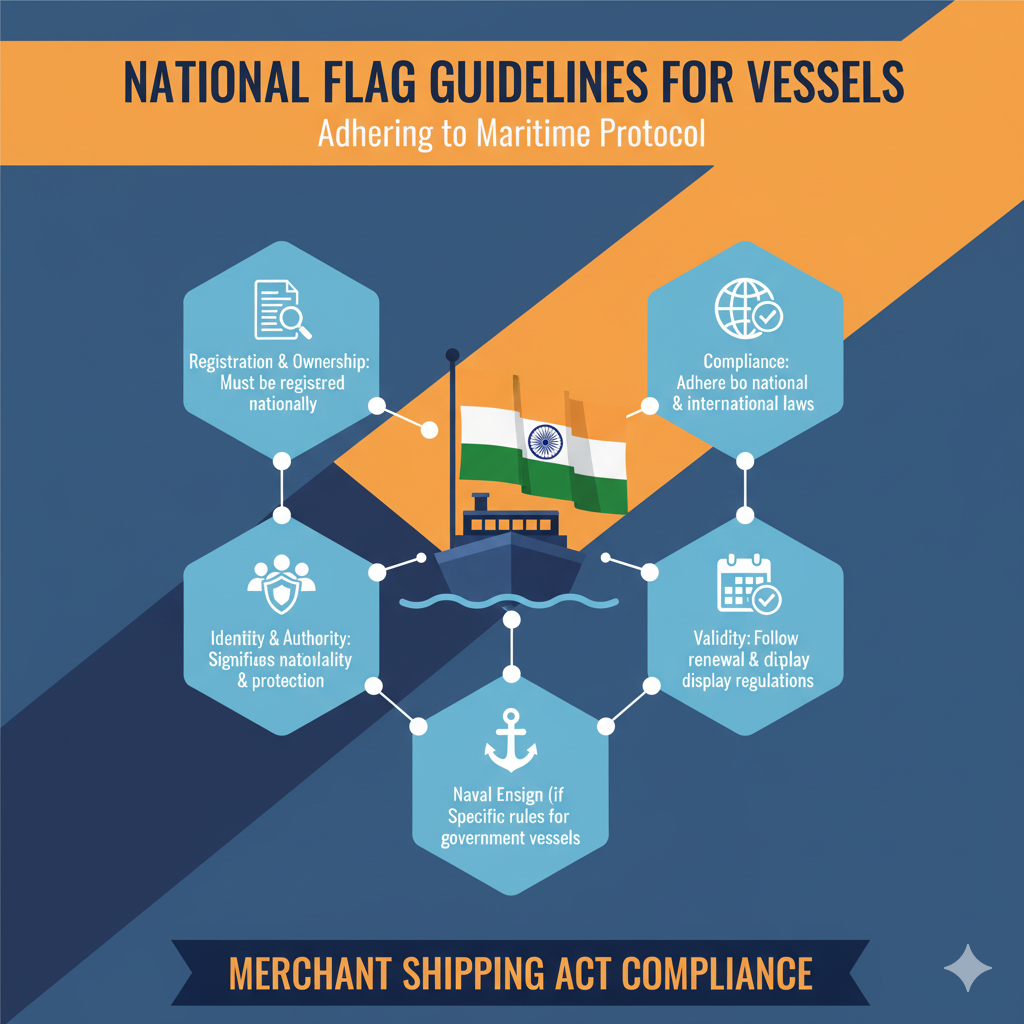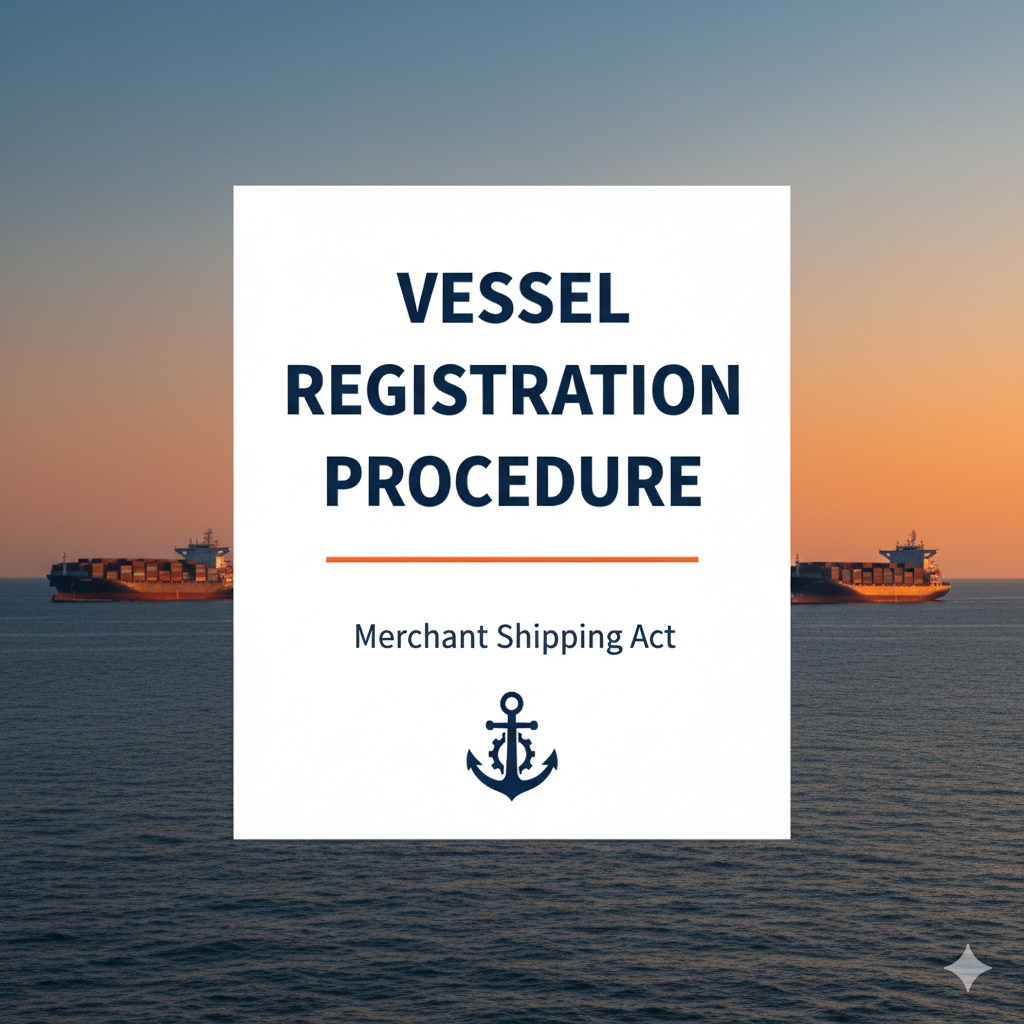With the rapid growth of India’s maritime industry and the regular heightening of the number of vessels inside the ports, it’s more crucial than ever to lay out a clear set of rules and procedures for the regulations of ships. MS Act, 2025 has set out a comprehensive framework for the registration and regulations of vessels.
This framework walks us through who it is for, why this framework is needed, how the registration process works and what rules apply to things like transfers, mortgages, and closing a vessel’s registration. This is to ensure transparency of ship ownership and regular access to surveillance. The framework of registration of vessels (Part III) of Merchant Shipping Act, 2025 from section 14 to 44 applies to all sea-going vessels.
But before we dive in make sure to read and understand the preliminary part of this act.

Guidelines/Criteria for the registration of vessels in India under MS Act, 2025.
A vessel is only considered an Indian vessel if its owned by:
- An Indian citizen, including NRIs or overseas citizens of India.
- A company or body established under the law of india with its office registered in india.
- Any other body or person allowed or specified by the central government through notification.
- No vessel which is wholly owned by an Overseas Citizen of India shall be required to be registered as an Indian vessel.
- The central government by notification can declare any port as the port of registry under this act and every vessel would be obligated to register itself under the said port.
- Any vessel previously registered will be considered registered after the commencement of this act and will be recognized as a registered vessel.
- All the government owned vessels other than vessels of the Indian Navy, Indian Coast Guard, customs authorities, Central Armed Police Forces and police, shall be registered under this Act. Some exceptions can be made when needed through the central government.
- An Indian vessel may be registered in a State other than India subject to such conditions as may be prescribed.
- If a foreign or abandoned vessel in Indian waters is acquired by an eligible Indian entity, it can be registered under this Act.
- Any ship that goes to sea without registration can be detained until it provides a valid certificate.
The principal officer of the Mercantile Marine Department or the central government may, by notification authorise, shall be the Registrar of Indian vessels at such port of registry as specified in the notification.
For other types of vessels:
Registration of Chartered Foreign Vessels:
- Any foreign vessel chartered on a bareboat charter-cum-demise contract by an Indian charterer may be registered under this Part in such manner and subject to such conditions as may be prescribed.
Temporary Registration for Recycling - Any vessel not registered under this Act which is sought to be recycled in India under the Recycling of Ships Act, 2019 may be registered temporarily under this Part in such manner, for a specified amount of time.
Provisional registration
- If, at any port or place a vessel becomes entitled to be registered as an Indian vessel, the Registrar may grant a provisional certificate of registration in accordance with such procedure as may be prescribed and such provisional certificate shall have the effect of a certificate of registration.
- The procedure for validity and extension or cancellation of such registration shall be such as may be prescribed.
- The unsatisfied mortgage shall continue to be reflected in the register book in case of deemed closure of the provisional registration.
And if you are a person looking to register your own maritime business and get an RPSL licence. You might want to get a clear idea of the criteria for it and get yourself a proper consultancy to guide you through it.
Procedure for the registration of vessels.
Every Indian vessel is prescribed to register under this procedure and payment of fees. And if the certificate of registration is expired it must be renewed as soon as possible. The director general can specify certain conditions for the types of vessels and the registrar is required to verify the ownership before granting the official registration.
The registered vessels will acquire two certificates:
- Certificate of Registration (ownership details)
- Tonnage Certificate (size and capacity details)
The damaged certificates can be replaced and if a vessel is lost, destroyed, captured or sold owners must report the incident immediately.
- Each vessel must have its own name, call sign and number.
- Registrars are required to maintain details of all the records.
- If the vessel’s ownership is changed, it is required for them to update the registration and acquire a new certificate.
Before we dive into the other set of rules for the vessel registration process, it is important and useful to understand the rules for establishment and empanelment of the national shipping board and seafarer welfare board, MS Act 2025.

Other rules regarding the procedure and transfer of ownership.
- If the ship registration is delayed for valid reasons the government will issue a temporary pass allowing the ship to sail for a limited period of time
- If the owner of an Indian vessel uses or attempts to use a certificate that is not legally granted, it shall be guilty of an offence under section 22 of Merchant shipping act 2025 and the vessel will be liable to forfeiture.
- If India is under war, external aggression or a national emergency is declared under article 352, no ship is allowed to be bought or sold without the approval from the central government.
- The transfer of Indian vessels are only allowed under these circumstances:
(a) all mortgages entered in its register are satisfied or the mortgagee has given his consent in writing for the transfer of the vessel;
(b) all wages and other amounts due to seafarers in connection with their employment on that vessel have been paid in accordance with the provisions of this Act;
(c) any subsisting entry has been made of any court order prohibiting transfer or any dealing with that vessel;
(d) any unpaid statutory fees that may be levied on the vessel has been paid and informed in writing to the Registrar. - Even if all the above conditions are met the transfer must be done through an official transfer instrument, if the ship is previously not registered then the transfer of ownership will not be legally recognised.
- In cases of death of the owner or insolvency the ownership can be transferred to someone else under prescribed conditions.
- If the ship is sold abroad or loses its Indian vessel eligibility, it can still be ordered to be sold as per government rules.
How do vessel mortgages work in India? Registration, transfer and rights.
Recording and rights of vessel mortgage
RECRODING: All vessel mortgages are required to be documented in legal form and submitted to the registrar for official recording, even after a mortgage is created, the mortgagor (owner) remains the legal owner of the vessel. When the mortgage fully gets discharged the registrar updates the register so that the ownership is fully under the name of mortgagor. If multiple mortgages exist, priority is based on the order of registration and not the date of the mortgage deed.
RIGHTS (Recovery of mortgage debt): If there is only one mortgage it is allowed to sell the vessel and recover the debt money without approaching the high court for approval but if there are multiple then the matters must be settled through the high court. In the first case the seller must notify the registrar and ensure all seafarer wages are paid.
Liability and protection of mortgages
If the mortgagee takes possession of the vessel, he is responsible for the following:
(a) managing the vessel as if it were his own vessel;
(b) making such necessary repairs to the mortgaged vessel as may be required for the smooth operation and normal functioning of the vessel;
(c) ensuring that no act is committed which is destructive or permanently injurious to the vessel; and
(d) such other liability as may be prescribed.
If the vessel owner becomes insolvent after the mortgage is recorded, the mortgage remains valid and the mortgagee’s claim will have a higher priority compared to the claims of other creditors during the proceedings of insolvency.
Transfer of mortgage and transmission of mortgage interest.
A registered mortgage can be transferred to another person through legal approved procedures and the new owner is entitled to all the same rights, and priorities as the previous mortgage holder. And if the mortgagee dies or becomes insolvent their rights will be passed down or transferred to a successor through legal process to ensure continuity and ownership rights.
From introducing the new merchant shipping act to taking Strict Action Against Forged CDC Entries in the Indian Maritime Sector the governance of the shipping industry keeps taking further steps for enhancement and enrichment of maritime.
Naming the vessel, alteration and national flag regulations.
Rules for naming a vessel:
- A registered Indian vessel can only be referred to by the name which was recorded during the registration process.
- A registrar can reject the name proposed if it is already used by another vessel or if it sounds very similar to that of another vessel’s name.
- A vessel name is only allowed to be changed under prescribed procedures.
- A vessel can or will be detained if the naming rules and regulations are not followed as prescribed.
- Foreign vessels are an exception for these rules as long as they are in the process of transitioning.
Alterations and certifications:
If a registered vessel is altered in a way that affects its original description then the owner is obliged to inform the registrar and the alteration must be recorded and re-registered if the changes are too vast. In cases of alterations while on foreign sea re-registration can be done after inspection by a surveyor, without requiring the vessel to sail back to India.
If the re-registration is happening at a different port than the vessels home port, the registrar can:
- Issue a provisional certificate showing the updated details, or
- Make provisional changes on the existing certificate
This allows the vessels to continue sailing until the documentations are fully processed.
Transfer of registrations and re-registrations of abandoned vessels.
The vessel’s registration can be transferred from one port to another if all registered owners and mortgagees consent in writing. The transfer does not affect anyone’s legal rights or interests in vessels.
A vessel that lost its Indian registration due to wreck, abandonment, or similar reasons cannot be registered again unless It undergoes a survey at the owner’s expense and Is certified as seaworthy by a surveyor.
National color guidelines for the vessels:

The central government will by notification declare what national colors (flags) must be used in Indian vessels and government owned ships. Indian ships must hoist the national flags when:
(a) on a signal being made to her by any vessel of the Indian Navy or Indian Coast Guard;
(b) on entering or leaving any port.
Naval, Coast Guard, and authorized officers may seize illegal or incorrect flags being used on vessels and non-Indian vessels cannot use the Indian flag to falsely appear as an Indian vessel, except when escaping an enemy in wartime. Here’s why Indian flagged vessels are important for the growth of trade, energy supply in addition to economic development.
Rules for Indian vessel identity, misrepresentation and forfeiture:
Under Section 38, it is strictly prohibited for any owner of an Indian ship to hide or misrepresent its nationality. This means they cannot carry false documents, use a foreign flag, or take any action that deceives authorities about the vessel’s Indian character. If any ship is legally deemed not to be an Indian vessel it will face the loss of its rights to diplomatic support offered to regular Indian ships and its right to fly the national flag but in the matters of paying dues, fines penalties and legal accountability for any offenses committed onboard, it will be treated as an Indian vessel.
If a vessel becomes liable for forfeiture because it violates nationality rules, authorized officials (including officers of the Indian navy, Indian coast guard, or Indian embassies) can seize and detain the ship. The case will be taken to the high court, which can order the vessel and its equipment to be forfeited to the government. In some cases, the responsible officer may receive a portion of the sale proceeds as awarded by the court.
Rules for shared ownership, register inspection and registration closure
Section 41 of Merchant shipping act 2025 states that if a person has beneficial interest in the ship they are equally responsible for all the legal liabilities such as fines and penalties as the registered owner, anyone can access the official registration records. By paying a certain fee anyone can access the official records and request copies of them, these copies would be just as valid in court as the original records.
The registered owner can request deregistration only when there are no outstanding mortgages or unpaid wage claims from the ship’s crew. Once verified, the registrar will close the registration and notify the Director General. This ensures that no vessel exits the registry with unresolved legal or financial obligations.
Power making rules – Central government
Under section 44, the last section of part 3 (Registration of vessels) Merchant shipping act 2025, the power of decision and rule making is stated to be for the central government and these are the areas it will be controlling and overseeing:
- (1) The Central Government may make rules to carry out the provisions of this Part.
(2) In particular, and without prejudice to the generality of the foregoing power, such rules may provide for all or any of the following matters, namely:
(a) The conditions for registration of an Indian vessel under sub-section (6) of section 15.
(b) The procedure for registration of an abandoned vessel under sub-section (8) of section 15.
(c) The manner and conditions for registration of a foreign vessel chartered on a bareboat charter-cum-demise contract by an Indian charterer under section 16.
(d) The manner, duration and conditions for temporary registration of a vessel sought to be recycled under section 17.
(e) The procedure for issuance of provisional certificate of registration under sub-section (1) and the procedure, validity, and extension of such registration or cancellation under sub-section (2) of section 19.
(f) The procedure, period and fees for registration and renewal thereof, of an Indian vessel under sub-section (1) and sub-section (2) of section 20.
(g) The manner and procedure in accordance with which the Registrar may require evidence to be given for the purposes of inquiring into the title of an Indian vessel under sub-section (4) of section 20.
(h) The form and manner of grant of certificate of registration and manner of determination of gross and net tonnage under sub-section (5) of section 20.
(i) The manner of granting a new certificate in lieu of the original certificate of registration being defaced or mutilated under sub-section (6) of section 20.
(j) The compliance of procedure by the owner of a registered vessel under sub-section (7) of section 20.
(k) The manner of description of the name, call sign and official number of Indian vessels under sub-section (8) of section 20.
(l) The manner of keeping the register book and making entries therein and maintenance of the records of vessels registered under this Act under sub-section (9) of section 20.
(m) The procedure for registration and issuance of a fresh certificate under sub-section (10) of section 20.
(n) The special circumstances for grant of temporary pass and the form in which such pass shall be granted under section 21.
(o) The form and manner of instrument by which an Indian vessel or share therein shall be transferred under sub-section (4) of section 23.
(p) The procedure for registration of the instrument by which an Indian vessel or a share therein shall be transferred under sub-section (5) of section 23.
(q) The procedure for transmission of property in Indian vessel on death, insolvency, etc., under section 24.
(r) The manner in which a vessel ceasing to be an Indian vessel is ordered for sale under section 25.
(s) The form of mortgage and the procedure and manner in which the Registrar shall record the mortgage in the register book under sub-section (1) of section 26.
(t) The documents required to be produced for the discharge of a registered mortgage of a vessel under sub-section (4) of section 26.
(u) The form of notice under sub-section (3) of section 27.
(v) The other liabilities of mortgagees under clause (d) of section 28.
(w) The manner for transfer of mortgage and the form of instrument affecting the transfer of mortgage under sub-section (1) of section 30.
(x) The procedure and conditions for transmission of interest in mortgage under section 31.
(y) The manner in which the name of an Indian vessel may be changed under sub-section (3) of section 32.
(z) The fee for inspection of the register book and a certified copy of any entry of the register book under sub-section (1) of section 42.
(za) The form and manner of application for closure of registration under sub-section (1) of section 43.
(zb) Any other matter which is required to be or may be prescribed.
To conclude the central governmenet will have complete control over monitoring, rule making and implementing systems for the betterment of the shipping industry under this act.
FAQ’s
1. Who can register a vessel as an Indian vessel under the MS Act 2025?
A vessel can be registered as an Indian vessel if it is owned by an Indian citizen, a Non-Resident Indian, an Overseas Citizen of India, or a company/body established under Indian law with its registered office or principal place of business in India. Certain other persons or bodies may also be eligible if notified by the Central Government.
2. What is a bareboat charter-cum-demise?
A bareboat charter-cum-demise is a type of bareboat charter where the ownership of the vessel is intended to be transferred to the charterer after a specified period. Under this Act a foreign vessel chartered under such a contract by an Indian charterer can be registered temporarily in India.
3. What is the process for provisional registration of an Indian vessel?
If a vessel is eligible for registration but the certificate has not yet been issued, the Registrar may grant a provisional certificate. This acts as a valid certificate of registration for legal purposes until the full registration is completed. The Central Government determines the procedure for validity, extension, or cancellation.
4. How are Indian vessels transferred or sold?
Transfers of vessels or shares must follow prescribed procedures using a registered instrument. During emergencies, war, or sanctions, prior Central Government approval is mandatory. Transfers are only valid if mortgages are satisfied, wages paid, and statutory fees cleared.
5. How are mortgages on Indian vessels managed?
Mortgages must be in prescribed form and recorded by the Registrar in the order received. The mortgagee is not deemed the owner, and the mortgagor retains ownership rights. Mortgages can be discharged, transferred, or transmitted on death or insolvency. Priority among multiple mortgages is determined by the time of recording, not the date of the mortgage itself.
6. What are the rules for naming Indian vessels and changing names?
Each Indian vessel must have a unique registered name, call sign, and official number. Names already in use or likely to cause confusion can be refused by the Registrar. Name changes must follow prescribed procedures. Foreign vessels registering as Indian vessels are exempt during initial registration.
7. What powers does the Central Government have to make rules under the MS Act 2025?
The Central Government can create rules covering registration, transfers, mortgages, provisional registration, and temporary registration for recycling. Rules may also include fees, documentation, compliance requirements, and procedures for closure of registration.

